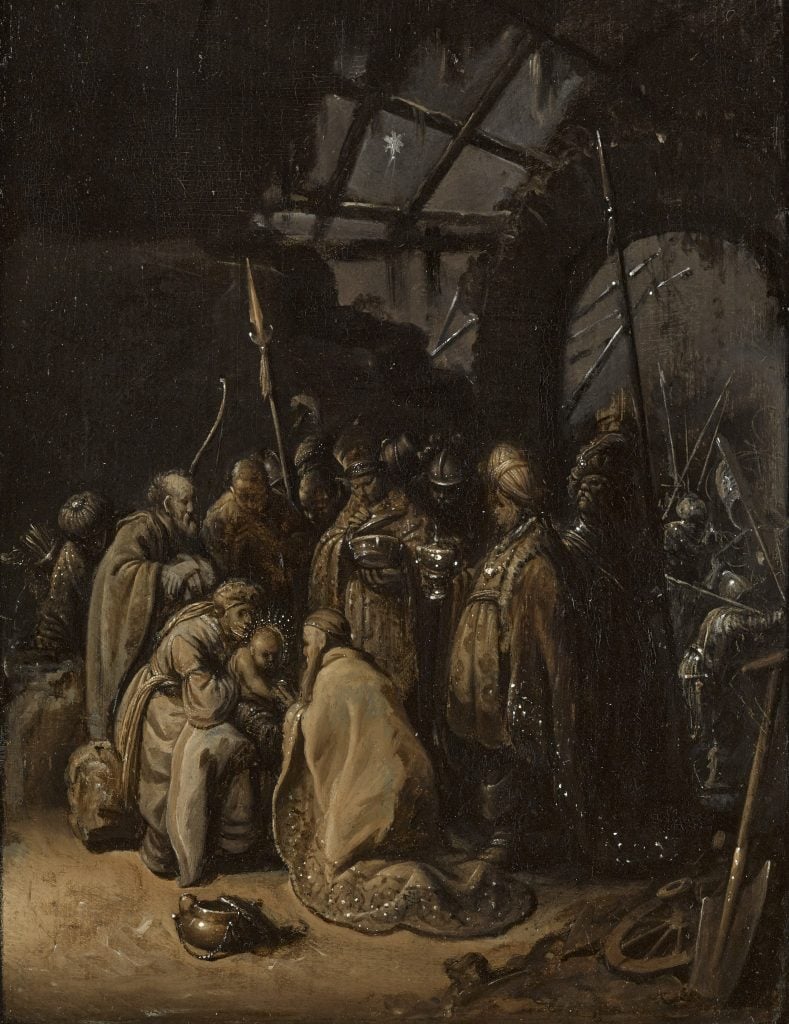Auctions
A Newly Attributed Rembrandt Once Valued at $10,000 Sold for Almost $14 Million
The painting vanished from public view in the 1950s, only to resurface in 2021 on the auction block.

The painting vanished from public view in the 1950s, only to resurface in 2021 on the auction block.

Adam Schrader

A rediscovered Rembrandt painting sold at auction on December 6 for nearly $14 million, a significant jump in value from just two years ago.
The rediscovered Rembrandt, titled The Adoration of The Kings (ca. 1628), vanished from public view in the 1950s, only to resurface in 2021 at a Christie’s sale in Amsterdam. At the time, the auction house catalogued it as a work from the “circle” of Rembrandt, estimating its value to be between $10,500 and $15,800.
However, it ultimately sold for nearly $1 million, buoyed by bids from those who thought it might actually the Old Master’s work. After an extensive examination that included infrared and x-ray imaging and inspection by leading scholars, Sotheby’s ultimately determined the work to be a real Rembrandt and estimated it could sell for $18 million.
The work sold for £10.9 million ($13.7 million) during the auction house’s Old Masters and 19th-century paintings evening sale in London on December 6.
To defend its status as a Rembrandt original, Sotheby’s spent eight months researching the painting before putting it up at auction. It also published an extensive essay detailing the painting’s history and the technique Rembrandt employed to make it. The painting is small in scale, just 9.6 inches by 7.2 inches, and uses an almost completely monotone palette like Rembrandt’s other small, monochromatic paintings he made with the intention of creating etchings of the compositions.
The scene depicts the Biblical account of foreign kings visiting Mary in a stable upon the birth of Jesus. It is visually and thematically similar to another alleged Rembrandt, The Adoration of the Magi, found in 2016.
The first record of The Adoration of The Kings comes from 1714 when it was listed in the inventory of the Dutch collector Constantijn Ranst, though Sotheby’s noted that it is hard to know for certain if that record—specifying “a small piece of the three Kings by Rembrandt”—is for this exact work.
The painting changed hands a few times after that, then largely disappeared from about 1822 until around 1955, when it was published in a catalogue of the collection of Dutch art collector J.C.H. Heldring. That was the last time the painting had been attributed to Rembrandt.
Rembrandt’s authorship of the painting was first challenged by German historian Kurt Bauch in 1960, who put an asterisk in his publication to note that he knew it only from a black-and-white photograph. However, that was likely the basis for scholar Werner Sumowski to erroneously attribute it to as a “studio work” in 1979.
From then on, it was no longer a Rembrandt—until it reemerged at the Christie’s sale.
More Trending Stories:
Art Dealers Christina and Emmanuel Di Donna on Their Special Holiday Rituals
Stefanie Heinze Paints Richly Ambiguous Worlds. Collectors Are Obsessed
Inspector Schachter Uncovers Allegations Regarding the Latest Art World Scandal—And It’s a Doozy
Archaeologists Call Foul on the Purported Discovery of a 27,000-Year-Old Pyramid
The Sprawling Legal Dispute Between Yves Bouvier and Dmitry Rybolovlev Is Finally Over